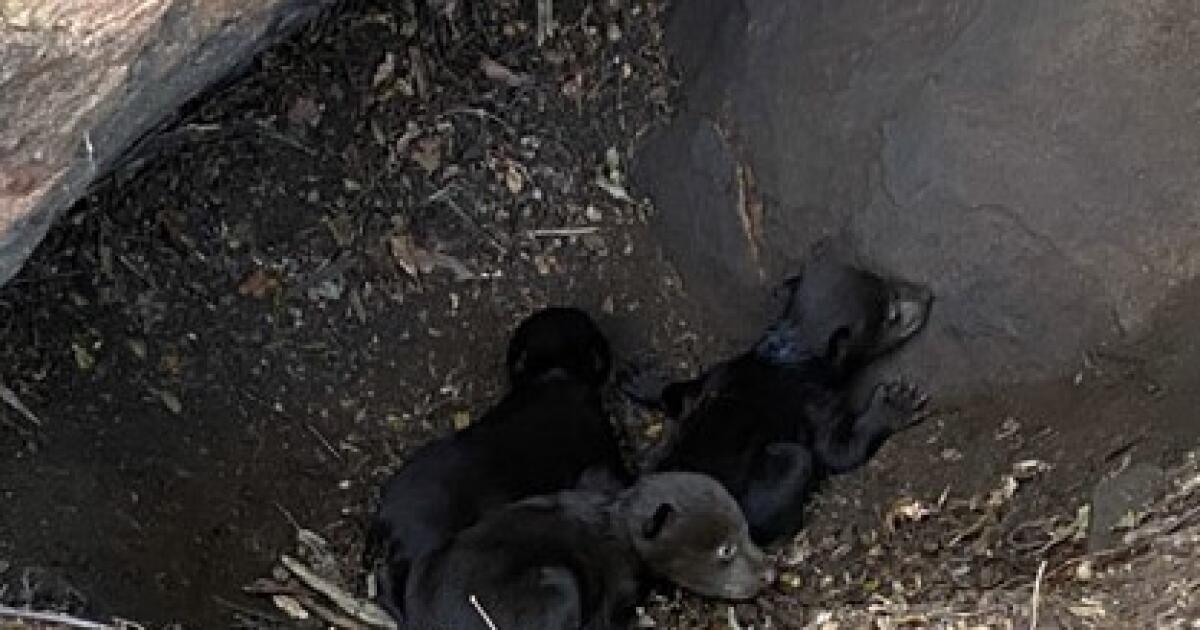The travel pattern resembled a Southern California hiker’s dream.
The journey began in Angeles National Forest above Glendora in May 2024 and progressed south into Azusa. There were stops, stays and starts from Monrovia and Sierra Madre, then northeast into La Cañada Flintridge, Tujunga and, eventually, the Santa Clarita Valley.
The route then turned southward into the Santa Susana Mountains, Simi Hills and then the Santa Monica Mountains before a couple of beach days and a return trip home.
But this trek — at least 100 miles — wasn’t some bucket list excursion or “only in L.A.” Instagram story. It was completed not by a hiker, but a roughly 175-pound female black bear known as Yellow 2291.
A black bear designated Yellow 2291 gave birth to three cubs, including this one, in mid-January.
(Steve Gonzalez / California Department of Fish and Wildlife)
The 5- to 7-year-old with a penchant for media coverage was recently spotted by Topanga residents with three cubs, making the quartet the first black bear family to reside in the Santa Monica Mountains in years.
Whether the arrival of her cubs will stanch the bear’s wanderlust is anyone’s guess. But nearby residents have expressed questions — and concerns — at their unfamiliar ursine neighbors.
“Occasionally a bear ends up in someone’s backyard, a pool, up in a tree, but very [rarely] in the Santa Monica Mountains,” Jeff Sikich, a wildlife biologist with the National Park Service, said at a Topanga Town Council meeting earlier this week.
The bear is known by two designations: Yellow 2291, due to a tracking tag applied to her by the California Department of Fish and Wildlife, and BB-14, used by the National Park Service to indicate that she’s the 14th black bear the agency has captured, tracked or collared since 2005.
Most previous bears were located in the Santa Susana Mountains as the park service trapped them while studying mountain lions.
What makes Yellow 2291 remarkable is her extensive wandering, according to Jessica West, a human-wildlife conflict specialist with the Department of Fish and Wildlife.
The bear initially gained attention when she wandered into a trap in Claremont on May 31, 2024.
At the time, wildlife officials estimated she was between 3 and 5 years old and weighed 175 pounds.
She was given an ear tag and a GPS collar, West said, and moved into Angeles National Forest.
That’s when her prolific journey began.
By June 2024, she had been documented traveling along the 210 Freeway corridor and crossing four major highways between the Santa Susana Mountains, Simi Hills and the Santa Monica Mountains.
She was spotted at Cheeseboro Canyon Park outside Agoura Hills before crossing major highways again and finding herself stuck in a tree in Chatsworth in July 2024.
“For whatever reason, she took a wrong turn, it seemed like, and ended up in very urban Chatsworth where she had no immediate access route back to her habitat,” West said.
Wildlife officials again placed her back into Angeles National Forest, where West believes she likely met her mate.
West said Fish and Wildlife was unaware of any male black bears in the Santa Monica Mountains.
Between August and September, the bear was spotted in Sylmar before returning to the Santa Susana Mountains and eventually traipsing into Malibu, where she was captured on Pepperdine University campus security footage.
She returned to an area near Topanga Canyon, where she denned for months, beginning in October.
In January, she birthed three cubs — two male and one female.
Since about April, she and the cubs have been spotted wandering around the Topanga area by residents.
West classified Yellow 2291’s travels as “extensive movement,” but said the department does not know why she’s traveled so much.
Sikich, the wildlife biologist, noted another bear with a large travel range: BB-12, a 4-year-old male who roamed 138 square miles over three months in 2023 before being struck and killed by a vehicle on the 101 Freeway.
He said BB-14 has traveled 47 square miles through seven months in the Santa Monica Mountains alone.
“We were not expecting to see this when we captured this non-target bear in Claremont,” she said. “So it’s been really incredible to see this range of movement, especially for a female bear.”

